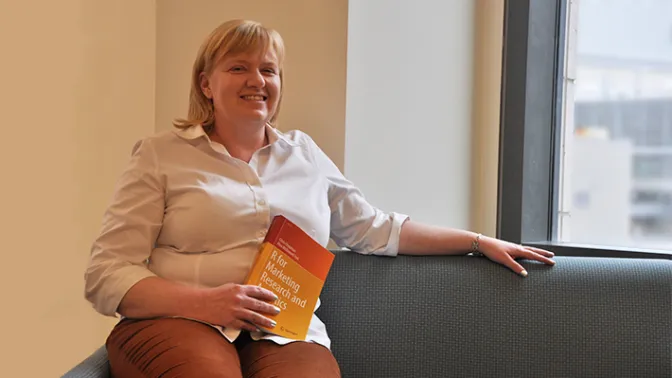
A Journey Through Data
Data is dirty. Or, before it’s scraped, cleaned, processed and organized by skilled analysts, data is often in the form of a messy tangle of information that’s of little use to anyone. Forward-thinking organizations know, however, that what lies beyond the daunting task of rendering data useful is a wealth of information that can impact every facet of how a company is organized and run.
When Korman Communities co-CEO Larry Korman and VP of Technology Bob Mahon sat down with Dean Paul Jensen to discuss opportunities for collaboration, they knew that their data fell firmly in the “messy” category, but they were willing to embrace the challenge. As a company that’s been in the real estate business for over 100 years, the sheer volume of information was overwhelming, but the firm is strongly committed to innovation and it knew the data held answers.
“We knew we had a lot of data, but like a lot of companies it was in a bunch of different places and it was very hard to make sense out of it,” says Mahon. “That’s how the conversation with Drexel got going. They said, ‘We think we can help you make sense out of that data.’”

Amenity Space at AVE Newtown Square
The leadership team at Korman Communities prides itself on being willing to take risks and learn from setbacks, but it needed to know that LeBow’s students could deliver solutions before handing over access to the company’s information. Korman and Mahon asked Dean Jensen and members of LeBow’s faculty and administration, “How can understanding data help us make our business better?”
As the conversation continued, Mahon expressed a desire to better understand the Korman customer’s journey, and he says some of those around the table suddenly “perked up” and explained that they had covered customer journey solutions in business courses. “We clicked immediately,” says Mahon.
With a specific question in mind, a project was organized through LeBow’s Center for Business Analytics and enlisted graduate students from the MS in Business Analytics program. The Korman Communities real estate portfolio is organized under two brands: AKA luxury hotel residences in metropolitan locations and AVE garden-style and mid-rise communities offering apartments and fully furnished suites. The leadership team determined that the students should begin by looking at the AKA brand’s customer data.

The Franklin Residences is located at 834 Chestnut Street and offers extended stay furnished suites and contemporary unfurnished apartments.
Professor of Management Information Systems Murugan Anandarajan recruited and organized the team of Graduate Analytics Fellows. Hong Li, a business analytics graduate student, was recruited to the team and brought valuable real-world experience from her previous work as a data analyst for an online retailer in China.
The team of eight students were given access to the data in December 2016. They had a mountain of information and few limitations — just a deadline to present their findings in June. The students were given so much freedom because, as Mahon explains, the Korman leadership team didn’t want to have too much influence on the findings. “I think what was really important was getting that new perspective — getting the outsider looking in to tell us how they see it,” he says.
The company’s openness to hear new ideas and challenges to previously held notions impressed Li as the students brought findings and recommendations to their regularly scheduled check-ins. “I appreciated that they had an open mindset to accept different, innovative ideas from students,” she says. “I think from the very beginning there was trust.”
That trust, and the Korman leadership team’s willingness to let the students’ analyze the data with autonomy, paid off. The team divided itself into three subgroups and scheduled weekly meetings with Professor Anandarajan. Each subgroup worked on a section of the supplied Korman data, but then used a technique called text mining to add more information from external sources including Booking.com and other reviews websites.
The sometimes-tedious task of compiling information from external websites and reviews paid off in what Mahon identifies as one of the more fundamental, but impactful, findings in the final presentation. “They identified for us how much of the AKA business was leisure travel. We thought it was the exact opposite. We thought most of the customers were business travelers, but they showed us that we had a very large number of leisure travelers. So it made us think differently about how we present ourselves and how we market,” says Mahon.
This insight would be put to immediate practical use as it confirmed that a “destinations” tab that was being considered in a new website design made practical sense. The tab was added to the homepage to highlight the AKA brand’s presence in tourist magnets such as Los Angeles, New York and London. And a plan to streamline the AKA INSIDER program, which encourages direct booking, was reinforced after the student analysts demonstrated how much AKA booking is done through third party websites and apps.
The shift to thinking about leisure travelers, and feedback analyzed through text mining analysis of reviews websites, also led to a renewed focus on front desk staffing at some properties. The AKA brand is defined as personal and “high touch,” so it was important that wait times be kept low during heavy check-in volume, but without losing the individual attention the customer expects.
As the students presented their final analysis, and the applicability of their findings became apparent, COO of Korman Communities Lea Anne Welsh’s reaction was a mix of being overwhelmed and eager for what would come next. “Knowing our entire company intimately, I sat there and I kept kicking Bob [Mahon] saying, ‘My gosh! We’re not even halfway through the presentation and there are 20 actionable items.’”
Welsh knew that she was interested in commissioning a second project focused on the AVE brand of luxury apartments and furnished suites and planning began almost immediately. Li remained with the company as an intern and provided continuity as a new set of business analytics MS students were organized and tasked with diving into a new set of data.

Korman Communities COO Lea Anne Welsh and Data Analyst Hong Li '18 in the lobby of AKA Rittenhouse Square.
Nick Biso, a recent graduate and current data analyst with JPMorgan Chase, was in that second group and would be chosen as his team’s leader and one of the final presenters. The dataset was different in that there weren’t reviews websites to mine from and a great deal of the available information came from resident surveys, but one element was consistent: “The data that we got was super messy and realistic,” Biso says.
When he talks about that data, Biso sounds like someone who was given a new toy, albeit one that proved to be extremely difficult to assemble. “We experienced what real data is about. There were missing values and it wasn’t as cohesive as the datasets that we use [in class],” he says.
After they had the data for approximately two weeks, the students were given a tour of an AVE property in Newtown Square, Pa. They were treated like prospective residents and got first hand experience that shed light on some of the feedback they were just beginning to analyze in resident surveys. Seeing the properties proved helpful as the team transitioned from crunching numbers to presenting cohesive feedback to Korman leadership.
Both Li and Biso point to preparing their presentations as unique learning experiences that stretched them beyond typical classroom work. “We were focused on results and data, but when we presented to Korman, they were focused on a lot of things we didn’t consider such as how the customer behaves and how our results impact the market and their competition,” says Biso.
In addition to what they learned from the customer experience surveys supplied by Korman, the group decided to add value to the project with census data to provide a profile of the neighborhood that surrounds each AVE property. This allowed the group to go beyond the original charge of describing the customer journey and answer a more fundamental question asked by Korman: “Who is our customer?”
What the students found has had an impact on how AVE markets its properties and designs its suites. The analysis of survey data revealed that residents valued the amenity spaces at AVE properties, contributing to a new approach to highlight them more prominently on the website. The students also revealed pain points: Some properties built in previous decades weren’t living up to the expectations of customers who have grown accustomed to bright spaces made possible by ubiquitous LED lighting. Korman implemented the obvious solution, adding more lighting, but also brought the feedback to their architects and designers to ensure that new buildings exceeded expectations.

AKA University City is located on the upper 18 floors of the Cira Centre South building at 2929 Walnut Street.
Beyond actionable findings, the students’ experience and advice helped evolve how Korman now approaches data. They’ve added more surveys and opportunities for customer feedback, but this time with the consistency that will ensure “clean” data for future analysts. “They truly did help push us along in some areas that weren’t on the radar to help us evolve our operation,” says Welsh.
For Li and Biso, the project was pivotal to their careers after graduation. Li, as a valued intern and integral part of both teams, was recruited to stay with Korman Communities as a data analyst. Biso credits his leadership role in the AVE project with building his confidence and considers the experience among the most valuable of his education as it forced a shift in focus that continues to pay off post-graduation: “When I was in school, I was too focused on the technical part of analytics. In this project I learned that it’s not all technical, you also have to learn business acumen, communication skills and how to deal with stakeholders,” he explains. “The business skills are just as important as the technical skills because without them you cannot successfully communicate the results.”


